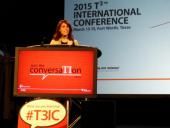T^3 2015 Day 1 Kickoff in Fort Worth, TX
Published by KermMartian
9 years, 1 month ago (2015-03-13T14:48:15+00:00)
| Discuss this article
General technology communities have E3 and CES, but we at Cemetech have Teachers Teaching with Technology or T^3, TI Education's annual conference. This year, we're bringing you the minute-by-minute updates from T^3 2015 in Fort Worth, Texas, right in TI Education's backyard. As in the previous two years that I attended, I'm looking forward to attending a lot of fascinating sessions with educators using TI calculators and connecting with teachers and with TI. I'll also be seeing how our mission to spread graphing calculators as a programming tool can fit into what else teachers do in the classroom. As always, keep your eyes on Cemetech for the latest that I and my colleague DrDnar discover here, experiences with the new TI-84 Plus CE, and everything else education and TI-related that we explore.
T^3 2015 kicked off with a drizzly Texas morning walk to the Fort Worth Convention Center, a short distance from our hotel. As is traditional for T^3 conferences, we were first welcomed by Gayle Mujica, TI's Marketing Director, then Peter Balyta, the President of TI Education. Both stressed the utility of the T^3 conference as a way both to learn from and teach your fellow educators and a forum to understand TI's technology and provide feedback back to TI. Since the conference is being held in Fort Worth, there will be a lot more TIers than usual attending. We also heard about tomorrow's Pi Day celebrations, including a 3.14-mile run and plenty of pie. Dr. Balyta introduced the two latest updates for TI's two hero lines: the new TI-84 Plus CE, and TI-Nspire OS 4.0's new math features.
The keynote speaker this morning was Dr. Jo Baoler, a mathematics education professor from Stanford. She spoke about her work in understanding and improving math education, especially with students who think they're just not good at math. Dr. Baoler led with neurophysiological research that shows there truly are not students who are innately better or worse at math, as demonstrated by the neuroplasticity of the brain. She led the audience through a fascinating example looking at how different people look at and interpret a diagram of a set of blocks that grows quadratically. We looked at a group of at-risk teens exploring this problem, and tried to understand what made them so enthusiastic to understand and solve this particular problem. Dr. Baoler left us with a few thoughts about what is good and bad about the state of math education, especially from a neurological standpoint: mistakes are good, and every time you make a mistake and learn from it, you grow a synapse.
If you're here at T^3, I hope you'll stop me, say hello, and share some of your own experiences with programming or with T^3, and keep your eyes on Cemetech for more from the conference.
Left to right: Introductions from Gayle Mujica, Peter Balyta, and Jo Baoler



Permalink
General technology communities have E3 and CES, but we at Cemetech have Teachers Teaching with Technology or T^3, TI Education's annual conference. This year, we're bringing you the minute-by-minute updates from T^3 2015 in Fort Worth, Texas, right in TI Education's backyard. As in the previous two years that I attended, I'm looking forward to attending a lot of fascinating sessions with educators using TI calculators and connecting with teachers and with TI. I'll also be seeing how our mission to spread graphing calculators as a programming tool can fit into what else teachers do in the classroom. As always, keep your eyes on Cemetech for the latest that I and my colleague DrDnar discover here, experiences with the new TI-84 Plus CE, and everything else education and TI-related that we explore.
T^3 2015 kicked off with a drizzly Texas morning walk to the Fort Worth Convention Center, a short distance from our hotel. As is traditional for T^3 conferences, we were first welcomed by Gayle Mujica, TI's Marketing Director, then Peter Balyta, the President of TI Education. Both stressed the utility of the T^3 conference as a way both to learn from and teach your fellow educators and a forum to understand TI's technology and provide feedback back to TI. Since the conference is being held in Fort Worth, there will be a lot more TIers than usual attending. We also heard about tomorrow's Pi Day celebrations, including a 3.14-mile run and plenty of pie. Dr. Balyta introduced the two latest updates for TI's two hero lines: the new TI-84 Plus CE, and TI-Nspire OS 4.0's new math features.
The keynote speaker this morning was Dr. Jo Baoler, a mathematics education professor from Stanford. She spoke about her work in understanding and improving math education, especially with students who think they're just not good at math. Dr. Baoler led with neurophysiological research that shows there truly are not students who are innately better or worse at math, as demonstrated by the neuroplasticity of the brain. She led the audience through a fascinating example looking at how different people look at and interpret a diagram of a set of blocks that grows quadratically. We looked at a group of at-risk teens exploring this problem, and tried to understand what made them so enthusiastic to understand and solve this particular problem. Dr. Baoler left us with a few thoughts about what is good and bad about the state of math education, especially from a neurological standpoint: mistakes are good, and every time you make a mistake and learn from it, you grow a synapse.
If you're here at T^3, I hope you'll stop me, say hello, and share some of your own experiences with programming or with T^3, and keep your eyes on Cemetech for more from the conference.
Left to right: Introductions from Gayle Mujica, Peter Balyta, and Jo Baoler



Permalink
Advertisement

